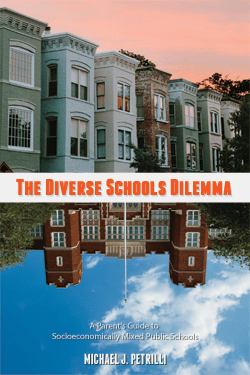 |
Both Brooklyn, NY, and Northwest D.C. are home to emotionally charged, racially tinged fights over neighborhood school boundaries. Urbanists beware: As the “great inversion” continues and our cities gentrify, this is a sign of things to come.
In Brooklyn, the fight is focused on two elementary schools in Park Slope. One of these, P.S. 321, is overcrowded, the result of a baby boom in its increasingly affluent community, as well as of a school-system policy that allows students to stay at the school even after their families move elsewhere in the city. To deal with the crowding, officials plan to shrink its attendance zone, which means redistricting some children into a new school to be opened a few blocks away.
That second school stirs anxieties among many middle-class parents because it will be more socioeconomically diverse. As Naomi Schaefer Riley opined in the New York Post,
Aren’t Park Slopers looking for diversity? Writing at Park Slope Patch last year, neighborhood resident Louise Crawford asked parents and leaders “What Matters to Park Slope.” From the president of the Park Slope Civic Council to the head of the advocacy group Park Slope Neighbors, diversity topped nearly everyone’s lists….
Matthew Didner, the acting chair of a group of parents whose kids are now zoned for the new school, tells me that diversity is very important to his neighbors. “One of the things that universally has been bemoaned is that the neighborhood is becoming more homogenous.”
Yet, as I told Ms. Riley, there’s diversity, and then there’s diversity. Many affluent parents like racial diversity because they want their kids to be comfortable in a multiracial society, but they are not excited about socioeconomic diversity because it will start to affect the quality of their children’s education.
A similar dynamic is playing out in the nation’s capital. Wilson High and Alice Deal Middle School, located in D.C.’s tony (and baby-booming) Ward 3, enjoyed massive physical-plant updates recently, with their buildings fully refurbished, expanded, and improved. Now affluent parents west of Rock Creek Park are sending their children to those schools in greater numbers than in decades.
That shift signals newfound confidence in the public schools, but it’s also creating headaches. The schools are getting crowded, and district officials are looking at shrinking their boundaries to address the problem. (Sound familiar?) The outcome is easy to predict: Students who live further away—who tend to be poorer and of minority races—will be rezoned to other campuses, and the Ward 3 schools will become dramatically less diverse.
Perhaps this homogenization of urban schools is impossible to avoid. If the demographics of certain neighborhoods become predominantly white and upper-middle-class, so will the schools, right?
But isn’t something lost when schools lose their diversity? Shouldn’t there be a way to create (and maintain) racially and socioeconomically diverse schools in the city? Kaya Henderson, D.C.’s schools chancellor, seems open to the concept. She tweeted the other day, “Could we create a series of voluntarily diverse schools in DCPS?”
The answer is yes, but officials in Washington, Brooklyn, and elsewhere need to move fast.
The first option is to ditch the old system of neighborhood zones and school-attendance boundaries. Instead, cities could create a “controlled choice” approach whereby nobody has the right to attend the school down the street but everyone gets to choose among several local campuses. An algorithm would consider parental preferences, as well as students’ socioeconomic status, to determine who gets into which schools—and to ensure that all schools end up diverse.
The smartest policy would probably combine the two approaches by creating “school choice” zones in gentrifying parts of cities.
This idea is a favorite among policy wonks like the Century Foundation’s Richard Kahlenberg. The problem is that controlled choice can be politically explosive, as Wake County Public Schools (in Raleigh, North Carolina) found out. Parents of all races love neighborhood schools and don’t take kindly to being told that they can’t send their children to nearest one if that’s their pleasure.
Another option is to create new schools—either independently operated public charter schools or district-run magnet schools—that feature special themes or approaches and attract (like a magnet) parents from all socioeconomic backgrounds. Magnet schools have been around for decades; purposefully diverse charter schools are relatively new but gaining steam.
The smartest policy would probably combine the two approaches by creating “school choice” zones in gentrifying parts of cities. One could use a controlled choice system to engineer socioeconomically diverse schools as more middle-class families come back to the public schools—and make sure that none of the schools ends up becoming all-rich or all-poor. At the same time, one could create new magnet or charter schools and place them in these zones as attractive, dynamic options.
Once a group of middle-class parents has taken hold at a school, it is politically impossible to dislodge them. Thus, the time to act is when the neighborhood has started to gentrify, but before school demographics shift. It's probably too late for Park Slope or Northwest D.C., but there’s still time to get it right in, say, Harlem or Capitol Hill—and similar neighborhoods nationwide.
The recent movement of white and middle-class families into many of our great cities provides the best opportunity in a generation to create racially and socioeconomically integrated public schools. But it won’t happen automatically, and the moment may be fleeting. If policymakers want to seize this opportunity, they must act now.
